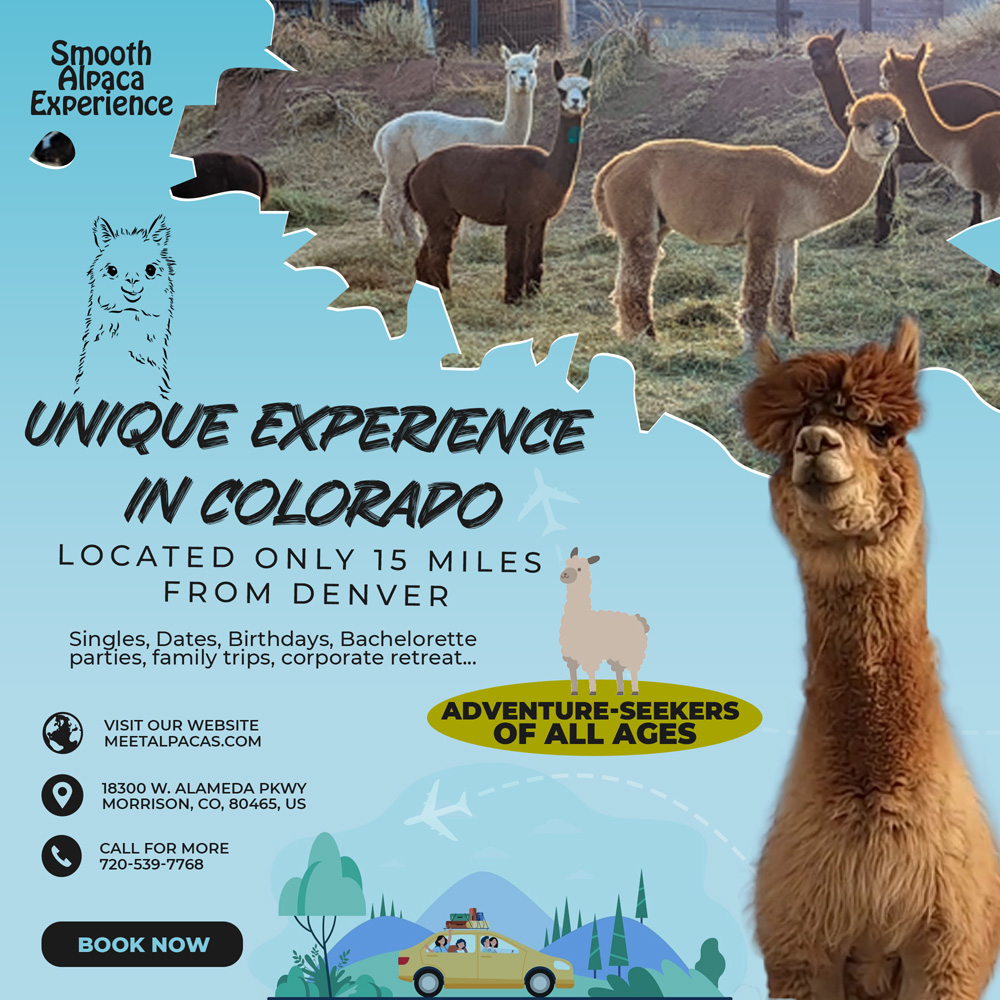Top alpaca adventures package and holiday advices in Colorado: Alpaca farms are a unique way to connect with nature and learn about sustainable living. These farms also host community events like shearing days, fiber arts classes, and farm tours, fostering a sense of community spirit. When you visit an alpaca farm, you’ll likely be able to see and even touch the herd. You can also shop in the store for products like hats, socks, and scarves made from the herd’s soft fleece. The ranch hosts special events and open farms to let people meet the herd and learn more about these wonderful animals. They have a wide variety of fiber artists who conduct workshops on creating items from the animals’ wool, and there’s even an alpaca-inspired coffee bar! Find more details at alpaca adventure tours in Colorado.

Alpacas have a lot to offer visitors. They are quiet, serene animals that graze peacefully in their pastures and often greet you with gentle nose kisses. They produce soft, silky fiber and are much warmer and stronger than sheep’s wool. They are easy to raise and get along well with other farm animals, making them ideal for hobby farms. They also qualify as livestock, which may allow you to take advantage of tax advantages and incentives.
Get ready for an Alpaca Adventure ! A Wildly Immersive and Hilarious Alpaca Adventure Perfect For All Ages : Embark upon an unforgettable magical experience with affectionate Alpacas, and explore the scenic mountain views of Red Rocks Park. We offer truly unique experiences that gets you up-close with these majestic friends. You’ll be entertained and educated on their habits, diets, and life on the ranch as you discover what makes these creatures so special.
Alpaca fur is a very prized fiber for artisans and crafters. Alpaca fur is very soft and does not retain water. It is also very durable. According to National Geographic, alpaca fur is the second strongest animal fiber, after mohair. Alpacas come in 22 colors, from a true, blue-black through browns and tans to white, according to Alpaca Ventures. Some Andean people eat alpaca meat. In Peru, it is often served in upscale restaurants. Alpacas don’t have teeth in the top-front of their mouths. This gives them the appearance of having an underbite.
All members of your group will have the opportunity to participate in a fully interactive experience. It typically lasts around 1 hour and 30 minutes. Its environment is ideal for nature lovers : Most people who live in Colorado love the outdoors because the state offers a little bit of everything. Even if you’re just visiting for the weekend, you can embrace all that nature has to offer. An alpaca ranch offers stunning scenery and a relaxing atmosphere where you can take in the fresh air. Are you looking for an educational opportunity for your kids? Come enjoy an alpaca experience that’s not only fun but also informative. This alpaca experience takes place on a fiber farm. This type of farm raises animals like alpacas, sheep, goats, llamas, angora rabbits, and more for their fleece and wool.
Are alpacas an “exotic species,” or are they considered simply “livestock?” Alpacas have been raised as domestic livestock for thousands of years. Since the end-product of alpacas is their fleece, like sheep, they are classified as livestock by both the United States and Canadian federal governments. Do alpacas spit? All members of the camel family use spitting as a means of negative communication. They do get possessive around food, and may express annoyance by spitting at other alpacas that they perceive are encroaching on “their” food. Also, they often spit at one another during squabbles within the herd (usually involving two or more males). From time to time alpacas do spit at people on purpose, but it is more common that humans get caught in the crossfire between alpacas, so it’s best to study their behavior and learn to avoid the most vulnerable situations. Read even more details at meetalpacas.com.
As with all livestock, owners and visitors should use common sense and a degree of caution when working around alpacas. People working with alpacas should wear long pants and shoes or boots that have traction and cover the whole foot. Proper handling of alpacas, as well as all camelids, requires humans gaining their trust by using a calm voice and light restraint. Handling alpacas for herd husbandry is best taught to novice alpaca owners by experienced owners or experts.
So what do you DO with these animals? Alpacas are raised for their soft and luxurious fleece (fiber). Each shearing produces roughly five to ten pounds of fleece per animal, per year. This fleece, often compared to cashmere, can be turned into a wide array of products from yarn and apparel to tapestries and blankets. The fleece itself is recognized globally for its fineness, softness, light weight, durability, excellent thermal qualities, and luster.
Alpacas hum; they make a sound like “mmm,” according to Alpaca Ventures. However, they also shriek when danger is present, and make a sound similar to a “wark” noise when excited. Fighting males scream, making a warbling bird-like cry. Alpacas in a herd all use the same area as a bathroom instead of defecating in random areas like many animals do. This behavior helps control parasites, according to the FAO. Males often have cleaner dung piles than females, according to Alpaca Ventures. Females tend to stand in a line and all go at once.